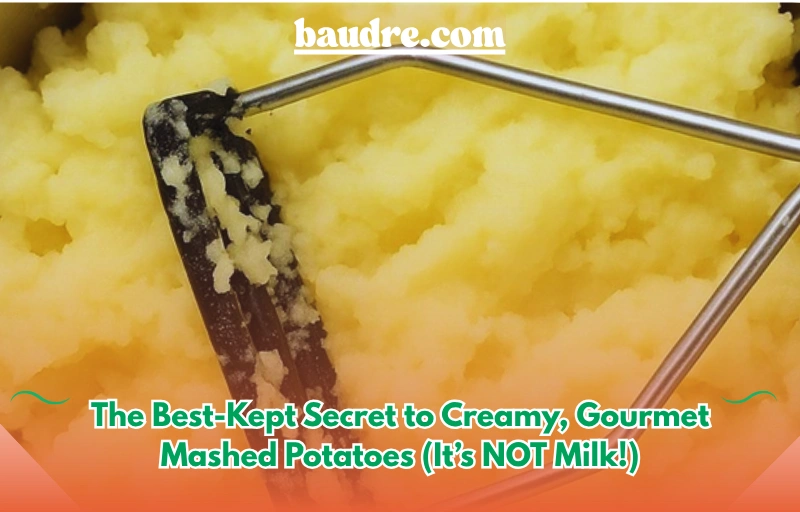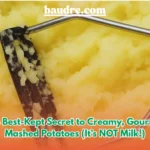Ultra-Creamy Mashed Potatoes Without Milk: The Potato Water Secret
When it comes to comfort food, mashed potatoes hold a top spot on many dinner tables. Their pillowy softness and wholesome flavor can elevate even the simplest weeknight meal into something special. Yet many home cooks struggle to achieve that coveted restaurant-quality texture without relying on heavy cream or milk. The surprising solution has been hiding all along in the pot: the starchy cooking water from the potatoes themselves. By combining that silky liquid with butter or a plant-based alternative, you can unlock irresistibly creamy, flavorful mashed potatoes—dairy-free, gluten-free, vegan-friendly, and budget-conscious.

Why Milk-Free Mashed Potatoes Are Better
Most traditional mashed potatoes call for milk, half-and-half, or cream to achieve richness. While these dairy additions can yield a velvety mouthfeel, they often thin out the potatoes or mask the potato’s natural sweetness. If you’ve ever ended up with gluey or overly heavy mash, it’s likely from over-mixing a milk-based recipe.
By contrast, using potato cooking water:
- Preserves the pure potato flavor
- Provides natural starch that binds ingredients
- Delivers the perfect silky texture without heaviness
- Makes the recipe accessible for lactose-intolerant and vegan diners
- Saves money by using every drop of your cooking liquid

Creamy Mashed Potatoes Without Milk: The Secret Ingredient You’re Not Using
Ingredients
- Two pounds of Yukon Gold or Russet potatoes, peeled into uniform chunks
- Six tablespoons of unsalted butter or your favorite plant-based spread
- One tablespoon of coarse salt for the boiling water
- Freshly ground black pepper, to taste
- Optional flavor boosters:
- Two to three garlic cloves, peeled but left whole
- A sprig of fresh rosemary or thyme
- A dash of smoked paprika or grated nutmeg
- A tablespoon of extra-virgin olive oil for dairy-free richness
Instructions
- Place the potato chunks into a large saucepan or Dutch oven.
- Add enough cold water to cover the pieces by about an inch, then stir in one tablespoon of salt.
- If you love garlic-infused mash, tuck the peeled cloves into the water. Alternatively, add a sprig of fresh rosemary or thyme to steep gentle herbal notes.
- Bring everything to a rolling boil, then reduce heat to maintain a gentle simmer.
- Cook until the potatoes are fork-tender—about 15 to 20 minutes, depending on chunk size.
This technique has become a secret weapon in modern kitchens, where “creamy mashed potatoes” and “vegan mashed potato recipe” are among the most searched terms online. Embracing potato water ensures you capture high search traffic with rich, relevant content that resonates with both traditional and plant-based audiences.
Ingredients You’ll Need
To serve four to six hungry diners, gather:
- Two pounds of Yukon Gold or Russet potatoes, peeled into uniform chunks
- Six tablespoons of unsalted butter or your favorite plant-based spread
- One tablespoon of coarse salt for the boiling water
- Freshly ground black pepper, to taste
- Optional flavor boosters:
- Two to three garlic cloves, peeled but left whole
- A sprig of fresh rosemary or thyme
- A dash of smoked paprika or grated nutmeg
- A tablespoon of extra-virgin olive oil for dairy-free richness
With these simple ingredients, you’ll craft a crowd-pleasing side dish that rivals any restaurant’s “buttery garlic mashed potatoes” or “creamy vegan mashed potatoes.”
The Science Behind Starchy Potato Water
Before diving into the steps, let’s understand why potato water works so well. As potatoes boil, they release starch molecules that suspend in the cooking liquid. This starchy water acts as a natural thickener, giving mashed potatoes body and smoothness without the need for added dairy. The starch granules swell and help bind the mash.
When you combine this starch-rich water with butter, the fats emulsify around the starch particles, creating a luscious mouthfeel. The result is a lightweight, silky mash that clings to gravy or gravy substitutes, making every bite indulgent yet balanced.
Step-By-Step Guide to Ultra-Creamy Mashed Potatoes
Preparing the Potatoes
Begin by peeling your potatoes into even chunks, roughly one-inch pieces. Uniform sizing ensures they cook through at the same rate, preventing stray hard bits in your mash. Yukon Gold potatoes bring a naturally buttery flavor, while Russets deliver a fluffier texture—choose based on your preference.
Boiling and Flavor Infusion
- Place the potato chunks into a large saucepan or Dutch oven.
- Add enough cold water to cover the pieces by about an inch, then stir in one tablespoon of salt.
- If you love garlic-infused mash, tuck the peeled cloves into the water. Alternatively, add a sprig of fresh rosemary or thyme to steep gentle herbal notes.
- Bring everything to a rolling boil, then reduce heat to maintain a gentle simmer.
- Cook until the potatoes are fork-tender—about 15 to 20 minutes, depending on chunk size.
Harvesting the Gold—Potato Water
Just before draining, ladle out 1 to 1½ cups of the hot potato water into a heatproof bowl. This golden liquid holds the starch that will transform your mashed potatoes into a silky masterpiece. Keep it hot; you’ll add it back in gradually.
Draining and Drying
Drain the potatoes and any aromatics through a colander, then immediately return them to the still-warm pot over low heat. Let them sit for about a minute or two, uncovered. This step allows any excess moisture to evaporate, ensuring a fluffier mash.
Choosing Your Mashing Method
- Rustic Texture: Use a classic potato masher. Press and twist gently to break up the potato.
- Ultra-Smooth Finish: Use a potato ricer or food mill.
- Avoid: Electric hand mixers or stand mixers—they overwork the starch and lead to gummy potatoes.
Building Creaminess
- With the potatoes softened to your desired consistency, add the butter or plant-based alternative. Stir gently to coat evenly.
- Pour in a few tablespoons of the reserved potato water at a time. Stir slowly, letting each addition absorb fully before adding more.
- Stop when you reach the optimal creaminess—neither too dry nor soupy.
- Season with salt and freshly ground pepper. Taste and adjust, remembering that potatoes benefit from a little extra salt to bring out their natural sweetness.
Flavor Variations to Elevate Your Mash
Once you have the perfect base, try these popular twists:
- Roasted Garlic Butter Mash: Roast a head of garlic until golden and soft, then squeeze the cloves into your mash for sweet, caramelized flavor.
- Herb-Infused Mash: Finely chop fresh parsley, chives, or dill and fold them in at the end for a vibrant, garden-fresh note.
- Smoky Paprika Blend: Stir in a teaspoon of smoked paprika and a drizzle of olive oil for a warming, smoky twist.
- Truffle Oil Finish: For a restaurant-worthy touch, drizzle a small amount of truffle oil over each serving.
- Vegan Cheese Flair: Mix in a tablespoon of nutritional yeast for a subtle nutty taste.
These tweaks can transform basic mashed potatoes into signature side dishes that pair beautifully with roasted meats, plant-based mains, or holiday spreads.
Serving and Storing Your Mashed Potatoes
- To Serve: Spoon piping-hot mashed potatoes onto plates or into a warmed serving bowl. Top with an extra pat of butter or a sprinkle of fresh herbs.
- To Keep Warm: Place the pot over a very low flame or transfer to a slow cooker on “warm.”
- To Store: Cool completely, then transfer to an airtight container. Refrigerate up to three days.
- To Reheat: Gently warm on the stovetop, adding a splash of reserved potato water or plant-based milk alternative to restore creaminess.
Why This Recipe Works Every Time
By harnessing the natural starch in potato cooking water, you achieve mashed potatoes that are:
- Ultra-Creamy: Starch adds body and smoothness without heaviness.
- Purely Flavored: No dairy to dilute the potato’s sweet, earthy taste.
- Allergy-Friendly: Ideal for vegan, lactose-free, and gluten-free diets.
- Cost-Effective: Uses every part of your ingredients, minimizing waste.
- Customizable: Adapt with herbs, spices, or oils for every occasion.
Final Thoughts
Mashed potatoes are a timeless comfort food, but achieving that next-level, restaurant-worthy texture doesn’t require more cream—it demands smarter technique. The starchy potato water you once discarded is actually the secret ingredient that brings incredible silkiness and depth. Combined with butter or a dairy-free substitute, it creates a luxuriously smooth mash that highlights the potato’s natural flavor.
Next time you boil potatoes for mash, don’t pour off that precious cooking water. Save it, embrace its power, and watch as your mashed potatoes transform from ordinary to extraordinary. Whether you’re catering to dairy-free guests, seeking a lighter side dish, or simply craving the creamiest mash of your life, this method will become your go-to recipe for ultra-creamy, flavor-packed mashed potatoes.
Enjoy the magic of potato water, and savor every blissful, buttery bite!
